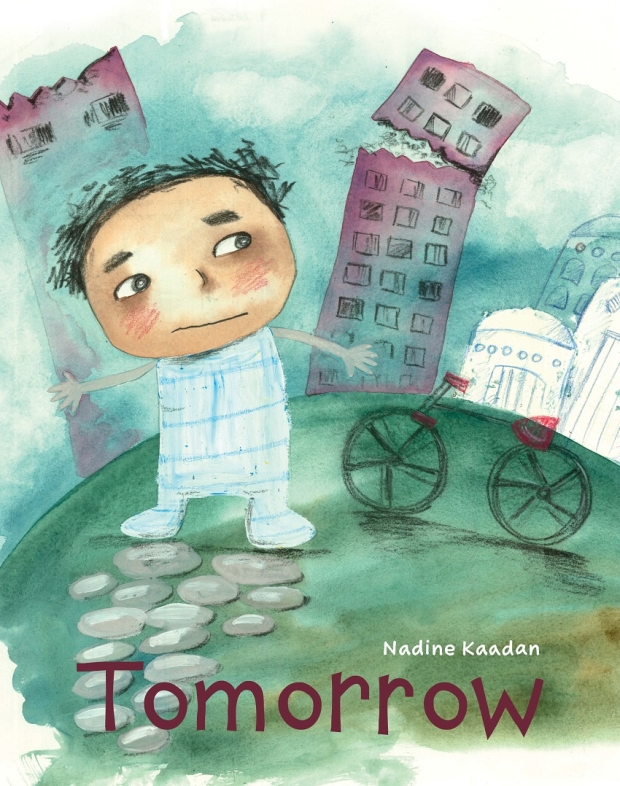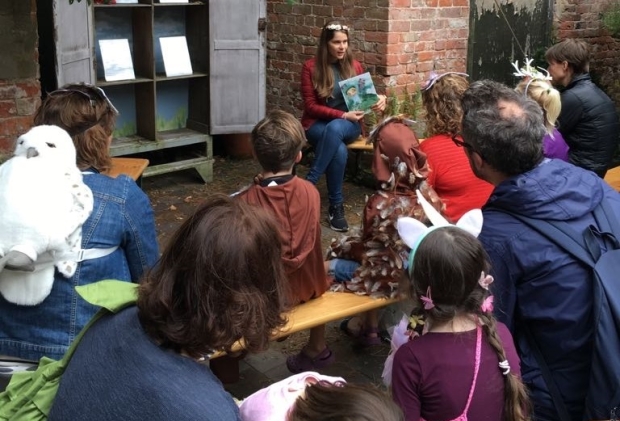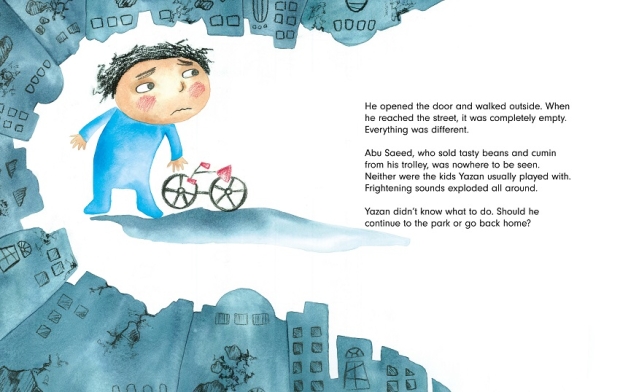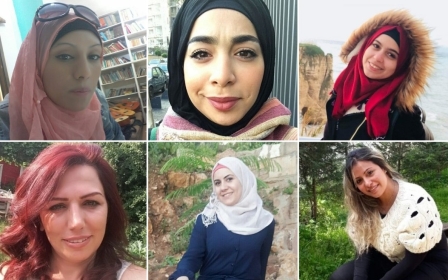'They have a right to understand': Syrian children’s author on stories of war

LONDON – Yazan is slumped in the corner of his bedroom, staring sidelong at the window where bright sunshine is being held back by a windowpane: “[He] no longer went to the park, and he no longer saw his friend who lived next door…Even his mother had changed. She had stopped painting.”
This is the opening spread of Nadine Kaadan’s book, Tomorrow, which was translated from Arabic to English and published in August this year. It illustrates the struggle faced by a child, such as her young Syrian protagonist, Yazan, who is desperate to go to the park but his parents won’t let him.
They don’t explain why it’s not safe to leave the house because they’re too busy watching the news “with the volume turned up loud… SO LOUD!”
The colours I was using changed. They became darker and scenes of war became my focal point. I was illustrating what we were seeing
- Nadine Kaadan
With the battle between government forces and a fractured opposition came the rise of the Islamic State group and intervention by international forces that is still continuing today.
“At the beginning, we refused to call it war,” Kaadan explains. “We didn’t want to believe it was anything more than a temporary conflict. We were in denial, which is why the word is never mentioned in the book.”
At the beginning, we refused to call it war…We didn’t want to believe it was anything more than a temporary conflict
- Nadine Kaadan
“I used to focus on illustrating my beautiful city in a dreamy way, drawing out the heritage, the architecture, the jasmine plants,” 33-year old Kaadan recalls. “But [after the start of the conflict] that stopped being my main focus, the colours I was using changed. They became darker and scenes of war became my focal point. I was illustrating what we were seeing.”
Grey tones fill the pages of Tomorrow, which seem haunted by ghosts of the dead and the living. Shadows stretch out to ghoulish proportions and crumbling apartment blocks rise out of the earth and hang down from the sky.
Even the “142 paper planes” Yazan makes to try and stem his boredom point downwards, an ominous reflection of the bombardment suffered by the population in a conflict that has so far left nearly half a million Syrians dead.
‘I don’t want to remember’
When Kaadan introduced Tomorrow to young Syrian refugees at a reading in Sweden recently, she was shocked by the reaction of one of her audience members. “Please don’t read it,” a young boy pleaded with her. “I don’t want to remember.”
The boy, who was around 10 years old, eventually decided to stay and by the end of the reading, he shared his own experience. “We had a park in Aleppo called Sabil,” he said. “But the last time I saw it, it had been destroyed.”
The popular Sabil park in the ancient city of Aleppo did not escape the fate handed down to it on what used to be the country’s commercial capital. Much of Aleppo’s infrastructure and heritage was destroyed in fierce fighting since 2012 before the city was recaptured by Assad's forces from rebels in December 2016.
It was really beautiful seeing the excitement in children’s eyes as they saw themselves in a children’s book and the way they related [to the story]
- Nadine Kaadan
“When I first read it five or six years ago, it was really beautiful seeing the excitement in children’s eyes as they saw themselves in a children’s book and the way they related [to the story],” Kaadan recounts.
“When it was over, they all wanted to tell their own stories. They talked about what they remembered of Syria, how they lived during the war. Some of them spoke of how in Syria they would picnic in the mountains; others said what they used to do when they were stuck at home and couldn’t go to school.”
But reading the book in 2018 presented Kaadan with a hard truth.
“When I read it [in English] this year, it was completely different. I was reading it to kids who were seven or eight years old. They don’t have any experience of Syria because they’ve been refugees all their life. They said they don’t remember anything. That’s really sad. After seven years of war, they have no memory of their own country. All they know is of being refugees.”
That’s really sad. After seven years of war, they have no memory of their own country. All they know is of being refugees
- Nadine Kaadan
“I wanted to find a way to explain to kids what was going on,” Kaadan explains. “It is worse to feel the trauma and sadness when no one has been brave enough to explain it to them. They have a right to understand why it’s dangerous outside. And that it won’t last forever.”
According to Kaadan, even the parents at her events related to the story of the housebound Yazan.
“One mum came up to me at an event saying that they would be dreaming of the park. She was so emotional and she was crying when she read the story, saying that all she had wanted to do was to take her children to the park and play. It’s something that is so symbolic of childhood, of freedom and continuing your daily life of being a child and just playing.”
And it is exactly this symbolic act, representing an innate human desire for freedom, that has helped the book gain broader appeal. Tomorrow is an optimistic title reflecting the hope of a nation for a better future.
'The Jasmine spirit'
From the age of 10 until she was around 14 years old, Kaadan produced a children’s magazine that she photocopied in black and white and then coloured in afterwards. Her mother paid the costs but she was able to distribute it cheaply to children at her school. For about 4 years, she published two to three issues a year. After studying Fine Arts at university in Damascus, she continued to illustrate Arabic children’s books before starting to publish her own stories.
In 2008, just after graduating from university, Kaadan celebrated her first published illustration, A Day on the Beach, an Arabic book for preschoolers from a Jordanian publishing house about a young boy and girl who spend a day together at the seaside.
It’s a story about Haroun, a Damascene cat who sets out on a mission to eradicate the source of his annoying sneezing fits: the city’s ever-present scent of jasmine. In doing so, however, Haroun incurs the wrath of the “Jasmine Spirit” who, according to Kaadan’s story, is said to have “lived in the jasmine trees of Damascus for thousands of years”.
The Best Fiction Book
The main character in her other book, Answer Me Leila, is deaf. Published in Arabic in 2011 by the Damascus-based publisher, Box of Tales, Answer Me Leila is a modern take on the story of Rapunzel from the Brothers Grimm fairytale collection. Awarded the "Best Fiction Book for Children with Special Needs" from the Anna Lindh Foundation in 2011, the book is dedicated to children with hearing difficulties.
People are fed up with the news, but through art and literature, we can talk about the deeper experience of the people who can use their own voices to tell their experience
- Nadine Kaadan
Leila lives in a tall tower and the male protagonist, Sami, does everything he can to draw her out of her isolation. Kaadan’s heroine tries all the tricks of the traditional fairytale such as dangling her long hair down to form a makeshift rope as well as writing him a letter, to no avail. Sami also fails to reach Leila by building a ladder before he eventually decides to try and decode the sign language she is using to communicate.
Through her books, Kaadan hopes to draw readers, unfamiliar with the context of her stories, a little closer to the culture she holds so dear.
“People are fed up with the news, but through art and literature, we can talk about the deeper experience of the people who can use their own voices to tell their experience, the war. And tell a different story, the story of the people.”
Middle East Eye propose une couverture et une analyse indépendantes et incomparables du Moyen-Orient, de l’Afrique du Nord et d’autres régions du monde. Pour en savoir plus sur la reprise de ce contenu et les frais qui s’appliquent, veuillez remplir ce formulaire [en anglais]. Pour en savoir plus sur MEE, cliquez ici [en anglais].










